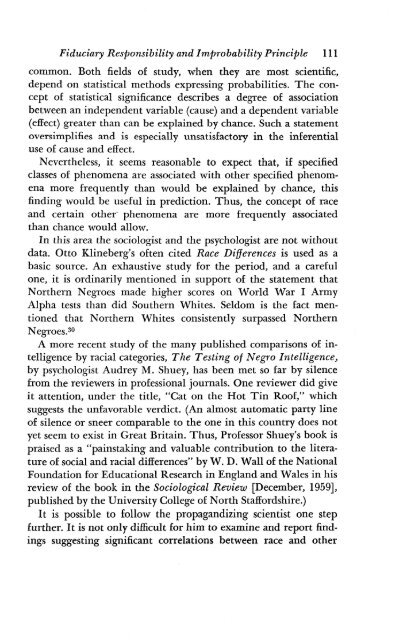Scientism and Values.pdf - Ludwig von Mises Institute
Scientism and Values.pdf - Ludwig von Mises Institute
Scientism and Values.pdf - Ludwig von Mises Institute
Create successful ePaper yourself
Turn your PDF publications into a flip-book with our unique Google optimized e-Paper software.
Fiduciary Responsibility <strong>and</strong> Improbability Principle III<br />
common. Both fields of study, when they are most scientific,<br />
depend on statistical methods expressing probabilities. The concept<br />
of statistical significance describes a degree of association<br />
between an independent variable (cause) <strong>and</strong> a dependent variable<br />
(effect) greater than can be explained by chance. Such a statement<br />
oversimplifies <strong>and</strong> is especially unsatisfactory in the inferential<br />
use of cause <strong>and</strong> effect.<br />
Nevertheless, it seems reasonable to expect that, if specified<br />
classes of phenomena are associated with other specified phenomena<br />
more frequently than would be explained by chance, this<br />
finding would be useful in prediction. Thus, the concept of race<br />
<strong>and</strong> certain other" phenomena are more frequently associated<br />
than chance would allow.<br />
In this area the sociologist <strong>and</strong> the psychologist are not without<br />
data. Otto Klineberg's often cited Race Differences is used as a<br />
basic source. An exhaustive study for the period, <strong>and</strong> a careful<br />
one, it is ordinarily mentioned in support of the statement that<br />
Northern Negroes made higher scores on World War I Army<br />
Alpha tests than did Southern Whites. Seldom is the fact mentioned<br />
that Northern Whites. consistently surpassed Northern<br />
Negroes. 3o<br />
A more recent study of the many published comparisons of intelligence<br />
by racial categories, The Testing of Negro Intelligence)<br />
by psychologist Audrey M. Shuey, has been met so far by silence<br />
from the reviewers in professional journals. One reviewer did give<br />
it attention, under the title, "Cat on the Hot Tin Roof," which<br />
suggests the unfavorable verdict. (An almost automatic party line<br />
of silence or sneer comparable to the one in this country does not<br />
yet seem to exist in Great Britain. 'Thus, Professor Shuey's book is<br />
praised as a "painstaking <strong>and</strong> valuable contribution to the literature<br />
of social <strong>and</strong> racial differences" by W. D. Wall of the National<br />
Foundation for Educational Research in Engl<strong>and</strong> <strong>and</strong> Wales in his<br />
review of the book in the Sociological Review [December, 1959],<br />
published by the University College of North Staffordshire.)<br />
It is possible to follow the propag<strong>and</strong>izing scientist one step<br />
further. It is not only difficult for him to examine <strong>and</strong> report findings<br />
suggesting significant correlations between race <strong>and</strong> other
















